
by Niall White | May 15, 2023 | Misc Awesomeness
I once listened to a city council meeting where one party was seeking exception to a rule. Other parties opposed the notion of such an exception, arguing it negatively impacted their lives. Residents and Council Members shared their thoughts. Some supported the exception, some did not. One Council Member gave an elaborate explanation of why the exception was the right thing to do, highlighting benefits to the public and effectively validating the arguments of the supportive party. Surprisingly, he then said he couldn’t support the exception.
He cited the law which, unless changed, clearly and effectively stated it couldn’t move forward. As I recall, others seemed to agree, even if begrudgingly. The meeting soon ended, and that was that. What had this council member done? He’d started by focusing positive aspects for the idea, validating and perhaps even empathizing. Couldn’t he have skipped all that, opening by citing the law? Yes, but those present might have had a very different experience.
Is focusing on problems inherently negative? I don’t think so. If we avoided anything negative, controversial, or potentially offensive, how would we learn, grow, and progress? The MITRE Innovation Toolkit Problem Framing and Rose, Bud, Thorn activities, for example, give permission to have difficult conversations about what’s going wrong, what’s going right, and opportunities for improvement.
When facilitated correctly, these hope-centric tools can be used in a space where participants feel safe, free to share their thoughts, and with an underlying theme that things will get better because of it! Like the council member described above, these tools can give people a chance to highlight the positives and negatives of a given situation.
People understandably become invested as the outcomes might directly impact their lives. They might become defensive, resistant to change, and even oppositional. I previously wrote an article, What Still Works, offering that by focusing on the things that work, we can sometimes deduce what’s actually wrong. In this article, I want to offer that in addition to identifying that which is broken, spending time thinking about what is right can also disarm, dissuade, and draft.
Disarm
People have opinions. That’s something to celebrate! What if you want people to have the same opinion on a given topic? Anyone who has tried to create such a reality knows how difficult it can be. One method is to explain what you think the correct opinion is, and then to tell everyone else they are wrong. You might not get any awards in resolving conflict, but an approach it remains. What if you started by highlighting the merits of both opinions? Like any conflict between two or more parties, starting with genuine empathy goes a long, long way. It might even disarm what could otherwise be a defensive party.
Dissuade
With defenses down, people might be willing to hear opposing viewpoints. If empathy, kindness, understanding, and acknowledgement of the positive aspects of others’ opinions continue, it could dissuade further negative actions and start paving a path for progress.
Draft
Feeling validated goes a long way. Validation might be the single most overlooked gift that can keep on giving. Asking oneself, “why might they feel that way?” or better yet, “have I ever felt that way?” is the beginning of real, positive change. Not only might an opposing party be disarmed from defensiveness and dissuaded from close mindedness, but they might also start seeing alternate viewpoints. At risk of using sports terminology incorrectly, perhaps someone might be drafted to a new team.
Focusing on what others are doing right, in addition to what they might improve upon, creates an empathetic space where both parties can feel validated. What do you lose by giving away such a gift?
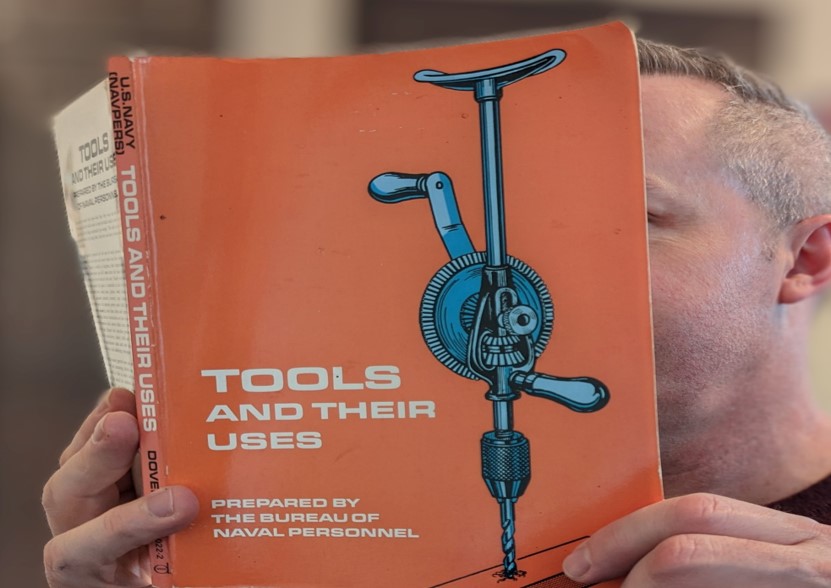
by dbward | May 1, 2023 | Misc Awesomeness |
When we first created ITK, there’s a reason we adopted a tool metaphor. We wanted to amplify the concept that tools are used to make things. Sure, it can be fun to become an expert in a particular tool (or toolkit!), but what matters most is not the tool itself. What matters is the thing you make.
The tool metaphor also highlights the fact that tools can be used in lots of different ways. A claw hammer can be used to sink a nail into a piece of wood. It can also be used to pull the nail out. I bought a screwdriver so that I could drive screws. But do you know what I mostly use that tool for? Prying open paint cans. And don’t get me started on my power drill (which I mostly use to drive screws, not to drill holes).
In keeping with this metaphor, we encourage creative use of the ITK tools. You are free to use these tools far beyond the typical applications and standard procedures. Avoid the purist approach, as if there is only One Correct Way to use the ITK tools.
By all means, use your hammer to sink a nail. Just keep in mind that it can also do the opposite.

by dbward | Oct 3, 2022 | Misc Awesomeness |
As the fable goes, the Tortoise and the Hare competed in a race—which culminated in the Tortoise winning and the (well-rested) Hare bemoaning an unexpected loss. Aesop’s narration may stop there, but the story itself doesn’t need to end. Viewed through the lens of the Innovation Toolkit, the Tortoise and the Hare would benefit from performing a retrospective analysis of their race, so they can identify lessons learned for the future.
Enter the Rose Bud Thorn tool!
Indeed, let’s have a little fun (we’re learning from anthropomorphic animals, after all), and say that the Innovation Toolkit was the race’s sponsor and that the Tortoise and the Hare—and the Fox judge—continue in their fabled roles. What happens next?
…
The Tortoise and the Hare linger at the finish line of the race, both eyeing the ITK banner fluttering in the wind. “What’s a Rose Bud Thorn?” asks the Hare distractedly.
“That’s a good question,” says the Tortoise, looking around for help. “Why don’t we ask our friend, Fox?”
“But… the race,” says the Hare. “I’m all ready to beat you if we try again!” However, the Tortoise has already started walking towards the Fox’s den. The Hare scrambles to catch up.
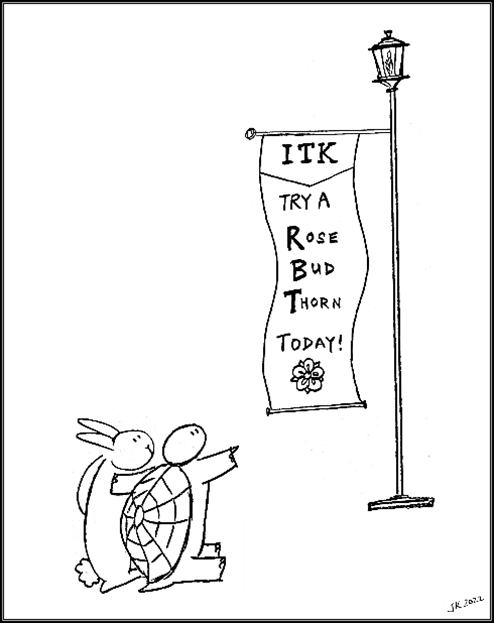 “Fox!” the Tortoise is saying. “Could you tell us what a Rose Bud Thorn is?”
“Fox!” the Tortoise is saying. “Could you tell us what a Rose Bud Thorn is?”
“Why, yes, Tortoise and Hare,” replies the Fox. “The RBT is an innovation tool for evaluating an event after it occurs. A retrospective, in other words.”
“I lost the race,” says the Hare. “What else could it possibly tell us?”
The Fox gives the question fair consideration. “Well, losing the race would be a negative, or “Thorn”—for you, at least. A “Rose” is something positive, such as getting good exercise, and a “Bud” is an opportunity or a potential, such as trying a different strategy next time. Also, those are just examples from your perspective, not Tortoise’s.”
The Hare looks intrigued, and the Tortoise slowly nods, so the Fox supplies them with pens and colored sticky notes to construct a simple Rose Bud Thorn on the grass. The Hare’s writing is scribbled, whereas the Tortoise’s is quite neat. Once they finish jotting down ideas, the Fox moderates a discussion between them, starting with the Roses, then the Thorns, and then the Buds. At the Fox’s suggestion, they conclude the session by placing small leaves on the sticky notes that resonated with them the most.
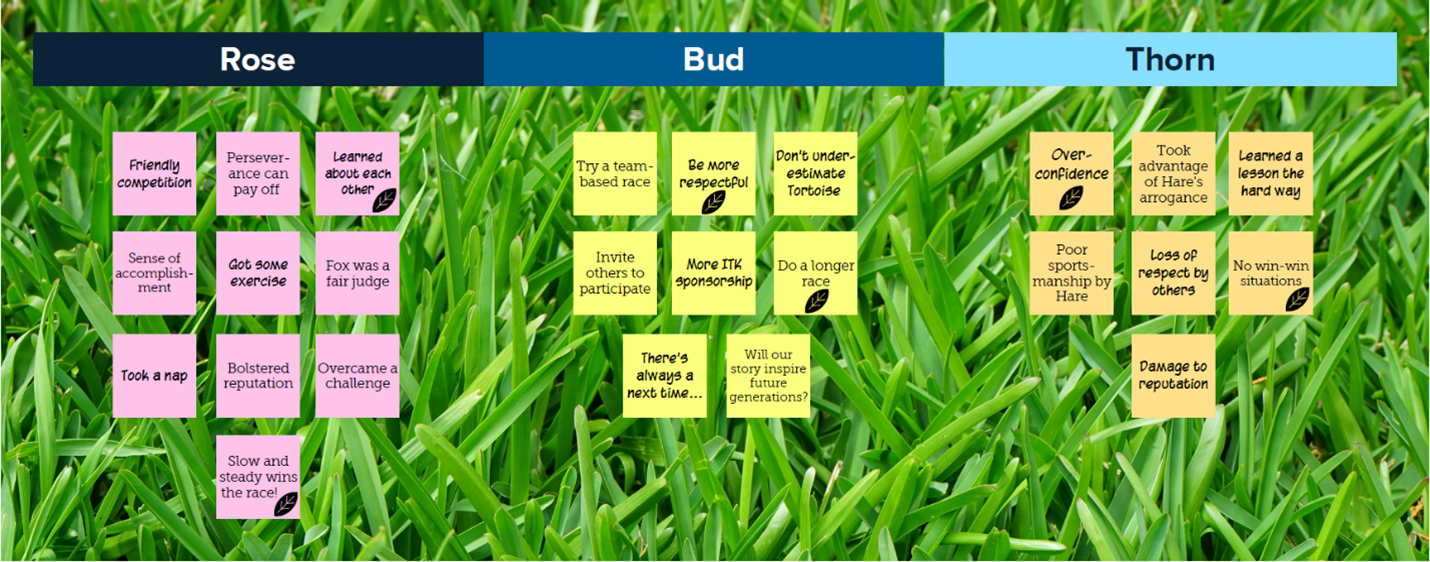
Feeling inspired, the Tortoise and the Hare thank the Fox and head out across the forest. The Tortoise, never one to back down from a challenge, suggests doing a marathon together, and the Hare, with newly acquired humility, agrees. From behind them, the Fox calls out, “Have you heard of the Premortem tool? It helps you define success, and it’s often used after the RBT. You could try to use it before the marathon!”
The Tortoise and the Hare wave at the Fox in a friendly way, but they are too deep in their discussion to turn around now. The Fox shrugs and settles down on the grass for a well-deserved nap. Eyes closing, the Fox reflects on the eventful day before murmuring wryly into the forest air:
“There’s always more to learn, isn’t there? Sooner or later, they’ll be back…”
Try a Rose Bud Thorn (or Premortem) Today!
by dbward | Jul 11, 2022 | Misc Awesomeness

Can we talk about feedback for a moment?
When you make something and share it with the world (an activity I highly recommend!), you’re creating a situation where people might express an opinion about what you created and shared. That’s kinda the goal and often is pretty great. Personally, I think it’s a real bummer when my creative efforts are ignored or met with silence.
But… let’s also note that getting feedback isn’t always giggles and rainbows either. Recently, I got two very different responses to my work – interestingly, these came in on the exact same day.
First, a friend sent me a link to a snarky, sarcastic video they’d found that was VERY critical of me and my work (and, for some reason, criticized my smile?). The video narrator did not show their face or their name (or their smile!), but they sure spent a lot of time showing my smiling face and saying my name. He got lots of things wrong in the video – for example he said I never worked as an engineer and was never in the military, although I in fact spent 20 years in uniform… as an engineer. Ironically, at one point he claimed to agree with me… on something my book does not say (in fact, it says the opposite). With so many facts wrong, he’s not exactly a critic I’m going to take personally or seriously, and his commentary clearly falls into the category of trolling rather than constructive criticism.
Later that very same day, I received a lovely, thoughtful review by someone who actually read my first book and thoroughly enjoyed it. She asked permission to send me a review she’d written – yes, I would be delighted to read your positive review of my work – and of course she signed her name to the request. It’s not often I get such an enthusiastic response to my work, and her review was a delicious antidote to the toxic spew from the earlier video.
I’m not sure what you’ll take away from this story, but it got me thinking about several things.
First, making work public is a social act, and I genuinely want people to respond to my work. I want to hear their responses and reactions.
Second, people can respond in very different ways to the same work… sometimes even on the same day!
And third, some responses are more valid than others. Yup, I liked the written review more, because it was positive and kind. But that review is also more credible, because she had clearly read the book, she got the facts right and offered direct quotes. Plus, she signed her name to the piece. I generally find anonymous opinions less credible than opinions accompanied by the person’s name.
So… when you share your work with the world (and I hope you do), prepare for people to respond to it (and I hope they do). Don’t let the haters drag you down and don’t let the positive reviews go to your head. In either case, don’t pay too much attention to anonymous comments, reviews that get the facts demonstrably incorrect, or gratuitous criticisms of your smile (I promise, your smile is lovely!). When you’re the one crafting a response of some type, sign your name if you want to be taken seriously. And of course, please be kind.
by dbward | Jun 20, 2022 | Misc Awesomeness
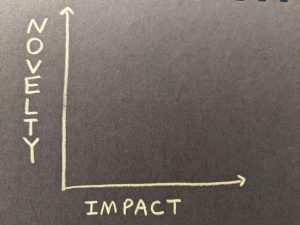
Here at ITK, we define innovation as “novelty with impact.” Just last week, it occurred to me to turn that definition into a graph, with Novelty along one axis and Impact along the other (seriously, how did I not think of this sooner?). At the low end of the Novelty axis, we find things that are Kinda Familiar, while at the high end things are Utterly Unique. Similarly, things at the low end of the Impact axis are Kinda Helpful, while the high end is full of products and services that SAVE THE WORLD.
So, the lower left quadrant might be minor innovations, things that are both kinda familiar and kinda helpful. The upper right quadrant is mega innovations. Both quadrants are innovative, just to different degrees. So far, so good, right?
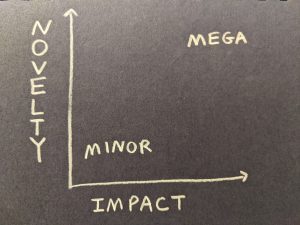 OK, the really interesting thing isn’t in either of those quadrants. Instead, it’s this arrow that points down and to the right. I call it the Innovation Maturity Slope, and it shows what happens when an innovative product or service becomes… popular (so maybe we should call it the popularity slope?).
OK, the really interesting thing isn’t in either of those quadrants. Instead, it’s this arrow that points down and to the right. I call it the Innovation Maturity Slope, and it shows what happens when an innovative product or service becomes… popular (so maybe we should call it the popularity slope?).
 Here’s what’s happening along this slope: popularity leads to familiarity, which reduces novelty. People see the thing and respond “Oh yeah, I’ve heard of that.” But popularity also means more people benefit from the thing, which means impact increases.
Here’s what’s happening along this slope: popularity leads to familiarity, which reduces novelty. People see the thing and respond “Oh yeah, I’ve heard of that.” But popularity also means more people benefit from the thing, which means impact increases.
The net result: popularity moves us down and to the right.
Think of what happens to an iPod, a cool new app, or the latest software development method. At first, a small number of early adopters use the thing, so it is relatively uncommon (high-N) and its impact is constrained to a relatively small group (low-I). It sits in the upper left quadrant. But later, everyone gets an iPod, discovers the app, or adopts Agile software methods. As more people use the thing and benefit from it, it becomes less novel but more impactful.
The reason I’m sharing this is to point out: this change can feel like a loss to the person behind the innovation. It might even feel like a failure, as if they “aren’t innovative anymore,” because their creation is less novel than it was before. It’s super easy to mistake a drop in novelty for a lack of innovation, even when impact is increasing. But the thing to remember is that novelty is not the point. For that matter, innovation isn’t the point either. Impact is the point – doing something that matters, solving a problem, creating value, helping people, making things better.
So if you are fortunate enough to see your project move to the right along the Impact axis, remember to count that as a sign of maturity and progress. It’s definitely a win.
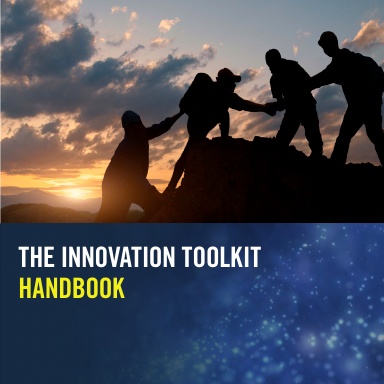
by dbward | Jun 16, 2022 | Facilitation Tips, Misc Awesomeness
Team Toolkit is excited to announce that WE WROTE ANOTHER BOOK!!
It’s titled The Innovation Toolkit Handbook. In this book, several members of Team Toolkit share our specific practices and processes as clearly and directly as we can, along with some reflections on why we do what we do the way we do it. It’s not exactly a sequel to our first book. Instead, we think the characters from our first book would have wanted to read this one. Basically, this handbook takes you behind the scenes and fills in some gaps the website and first book don’t cover. You’ll find chapters about Team Toolkit’s culture, our certification process for new facilitators, and our method for developing new tools. We also share tips on how to use the tools, perspectives on failure, and commentary on a collection of adjacent topics that don’t quite have a home on our website.
You can get the PDF version for free right here. It’s also available as a paperback for $8.35 (plus shipping).




 “Fox!” the Tortoise is saying. “Could you tell us what a Rose Bud Thorn is?”
“Fox!” the Tortoise is saying. “Could you tell us what a Rose Bud Thorn is?”


 OK, the really interesting thing isn’t in either of those quadrants. Instead, it’s this arrow that points down and to the right. I call it the Innovation Maturity Slope, and it shows what happens when an innovative product or service becomes… popular (so maybe we should call it the popularity slope?).
OK, the really interesting thing isn’t in either of those quadrants. Instead, it’s this arrow that points down and to the right. I call it the Innovation Maturity Slope, and it shows what happens when an innovative product or service becomes… popular (so maybe we should call it the popularity slope?). Here’s what’s happening along this slope: popularity leads to familiarity, which reduces novelty. People see the thing and respond “Oh yeah, I’ve heard of that.” But popularity also means more people benefit from the thing, which means impact increases.
Here’s what’s happening along this slope: popularity leads to familiarity, which reduces novelty. People see the thing and respond “Oh yeah, I’ve heard of that.” But popularity also means more people benefit from the thing, which means impact increases.